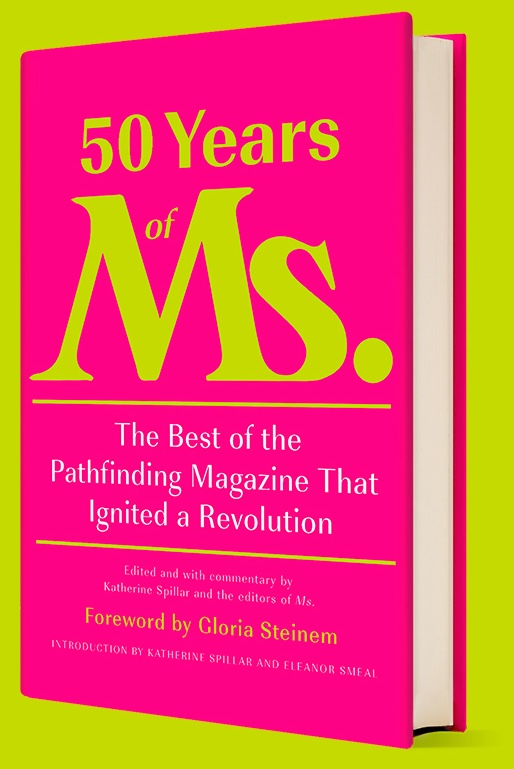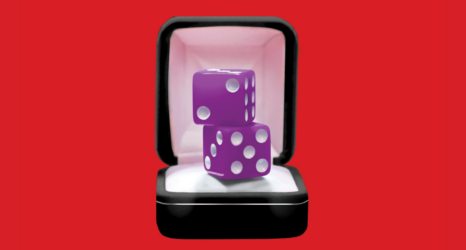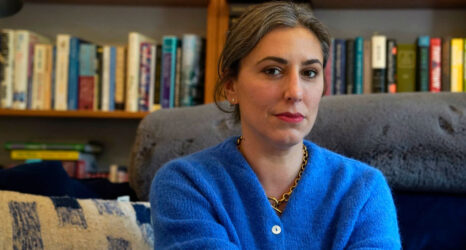
To pay tribute to five decades of reporting, rebelling and truth-telling, From the Vault includes some of our favorite feminist classics from the last 50 years of Ms. For more iconic, ground-breaking stories like this, order 50 YEARS OF Ms.: THE BEST OF THE PATHFINDING MAGAZINE THAT IGNITED A REVOLUTION (Alfred A. Knopf)—a stunning collection of the most audacious, norm-breaking coverage Ms. has published.

This article originally appeared in the Fall 2010 issue of Ms.
For many of us destined to become feminists, there’s a period when gender roles become ill-fitting and maddening, but we’re not sure why. At that crucial moment, certain books can offer refuge or escape—or provide our first “click!” moment, when we realize the problem’s not us, it’s society, and we’re not alone.
What most of these books have in common is a certain kind of hero(ine): young, brave, rebellious and independent. She disguises herself as a boy to be trained as a knight (Alanna in Alanna: The First Adventure); she drives a flying car across the U.S. to stop an alien invasion (Gratuity in The True Meaning of Smekday); she defends her father before an angry lynch mob (Scout in To Kill a Mockingbird). And although she may face flak for her nonconformity, ultimately it serves her well.
Such protagonists date back to the birth of modern fiction: Lizzy Bennet of Pride and Prejudice (1813), Jo March of Little Women (1869), Anne Shirley Blythe of Anne of Green Gables (1908).
Sure, these tomboys sometimes ran afoul of the mores of their times—Jo and Anne are forever despairing of ever becoming ladylike—and their tales tend to end in prescribed wedded bliss. But it’s the Anne Shirley who walked the roofline on a dare that generations of girls remember and love, not Anne Blythe, wife of Gilbert, mother of seven.
In the past century, they’ve been joined by a host of literary sisters who are unrepentantly bold. Today such books fall into the publisher category of “young adult” fiction, meaning, roughly, “marketed to 12-to-17-year-olds.” Right now, that’s a hot market, in light of the success of Harry Potter and Twilight (which, admittedly, Ms. has harshly critiqued for its gender dynamics). When the recession slammed adult book sales in 2008-2009, the young adult (YA) genre enjoyed 30 percent growth. In meeting the hunger for YA, a driving question for editors is: What do girls—the majority of YA readers—want? The answer is usually: cool girls.
“I needed [fictional heroines] when I was 11 years old and my parents had become strangers, my body was going psycho, and my friends had turned into evil junior-high aliens,” wrote Erin Blakemore in her ode to the female bildungsroman, The Heroine’s Bookshelf: Life Lessons, From Jane Austen to Laura Ingalls Wilder.
Coming of age can be rough for girls. As psychologist Mary Pipher documents in her 1994 book Reviving Ophelia: Saving the Selves of Adolescent Girls, girls take a nosedive in self-esteem when they hit puberty. Pipher blames media, social and family pressures and consumerist culture for straitjacketing girls into narrow ideals of femininity.
It’s no accident that YA speaks directly to this moment. “Children’s writers and editors are aware of the falloff in self-esteem that happens to girls at a certain age. And we love giving them kick-ass characters and role models,” says Karen Wojtyla, editorial director of Margaret K. McElderry Books, Simon & Schuster’s literary children’s book imprint.
Girls take a nosedive in self-esteem when they hit puberty. … It’s no accident that YA speaks directly to this moment.
Even as teen girls quit sports at a rate six times that of boys, YA is full of girls performing amazing physical feats—riding on dragons, coasting on levitating skate-boards, fighting zombies. And for girls dealing with darker issues, YA can be both escape and succor.
For girls of color, marginalized by the triple whammy of age, race and gender, YA can provide a thrilling moment of self-recognition.
“I’ve always felt detached from both of my cultures; my dad is Mexican, and my mom is white,” said Kerensa Cadenas, a Ms. intern. “So when I read [Sandra Cisneros’ novels] Caramelo and The House on Mango Street, I was able to recognize myself in characters who felt as though they didn’t completely fit in either.
There’s a reason why YA offers such counternarratives. The genre was first carved out of children’s books in the late ’60s in recognition that older teens wanted weightier subject matter. YA covered political issues of the time, such as war and civil rights, but also anything outside the cookie-cutter ’50s ideal, such as brown skin, poverty, depression, homosexuality and wobbly family structures.
Yet surprisingly, this rich and nourishing genre, crafted to engage teens, still evades high-school curricula. With a handful of exceptions—such as Mildred Taylor’s landmark novel about the Jim Crow South from the perspective of 9-year-old Cassie Logan (Roll of Thunder, Hear My Cry) or Julia Alvarez’s epic tale of four sisters fleeing the Dominican Republic for the U.S. (How the García Girls Lost Their Accents)—YA is by and large eschewed in favor of pale, male classics such as Catcher in the Rye and Of Mice and Men. Nor does that seem to be changing, with “No Child Left Behind” giving teachers little room for innovation.
Outside the classroom, however, YA is booming. Post Harry Potter and Twilight, Hollywood is falling over itself to secure the movie rights to YA novels. The next hot property is Suzanne Collins’ 2008 novel The Hunger Games; the just-finished film script had, at press time, six top directors (only one a woman) vying to helm it.
Not only is the industry paying attention, but adult YA fans are growing in numbers—and even straight teen boys are picking up Twilight and its successors. “It’s so they have something to talk about with the girls they like,” Patton told me—and in the process, they may absorb the perhaps unfamiliar idea that girls can be both human and heroic.
“It’s thrilling that teenage girls, who are pretty often denigrated as silly, shrieky, girly—have created this golden age of a genre by loving literature,” said Sarah Rees Brennan, author of The Demon’s Lexicon (2008). Brennan is part of a coterie of 18 women fantasy writers who went on the 11-city “Smart Chicks Kick It” book tour this September, the name celebrating both their characters and their fans. Coming out of a strong tradition of feminist fantasy by the likes of Marion Zimmer Bradley, the majority of the writers self-identify as feminist.
Brennan said, “Holly Black [The Spiderwick Chronicles], Cassandra Clare [The Mortal Instruments] and I have talks all the time about our female characters and inverting gender roles and romantic tropes!”
With writers like those, the paranormal YA explosion has been great at proliferating kick-ass girls; even Twilight author Stephenie Meyer calls her character Bella a feminist. But like the adult fantasy that preceded it, the genre has been less great at showcasing protagonists of color.
In protest, white feminist Justine Larbalestier, author of such YA fantasies as Magic or Madness, How to Ditch Your Fairy and Liar, has deliberately never written a white main character.
“Part of what I keep hoping is that when a book like Liar [with a mixed-race protagonist] does really well, it will help publishers realize there’s an audience for books about people who aren’t middle class and white—and that those books are read by black kids, brown kids and white kids,” she said.
She also got into a public tussle with her publisher to ensure that on Liar’s cover the character’s skin be visibly dark—so that it’s clear to those buying the book that she’s of color.
Writers to meet this audience are out there, everyone agrees; it just requires a powerful editor willing to take a chance on a new voice. That’s what happened for Nnedi Okorafor, a Cincinnati-born daughter of Nigerian immigrant parents who defies genre with her unique brew of magic realism, fantasy, science fiction, Nigerian folklore and bits and scraps of other West African cultures. For years, she shopped her fiction to editors who told her that it was good but too difficult to categorize. Finally, Andrea Pinkney, then-head of Houghton Mifflin’s children’s department, signed Okorafor and published Zahrah the Windseeker (2005) and then the multiple-award-winning The Shadow Speaker (2007).
“This is a big world with so many different legends and traditions and cultures. We can’t just stick with a few in one part of the world,” Okorafor said. Okorafor’s Nigerian-myth-born fantasy feels dazzlingly, gorgeously new. Feminist, speculative-fiction legend Ursula K. Le Guin concurs: “There’s more vivid imagination in a page of The Shadow Speaker than in whole volumes of ordinary fantasy epics.”
As YA gains mainstream appeal and takes its awesome girl protagonists with it, we need to make sure that kick-ass action girls or vampire heroines don’t create new boxes to stuff girls into. The boundary-pushing genre of YA must continue to push—and fortunately, Okorafor and others like her are out there to make it happen.
Up next:
U.S. democracy is at a dangerous inflection point—from the demise of abortion rights, to a lack of pay equity and parental leave, to skyrocketing maternal mortality, and attacks on trans health. Left unchecked, these crises will lead to wider gaps in political participation and representation. For 50 years, Ms. has been forging feminist journalism—reporting, rebelling and truth-telling from the front-lines, championing the Equal Rights Amendment, and centering the stories of those most impacted. With all that’s at stake for equality, we are redoubling our commitment for the next 50 years. In turn, we need your help, Support Ms. today with a donation—any amount that is meaningful to you. For as little as $5 each month, you’ll receive the print magazine along with our e-newsletters, action alerts, and invitations to Ms. Studios events and podcasts. We are grateful for your loyalty and ferocity.





